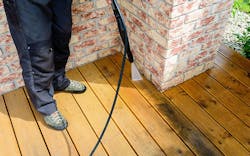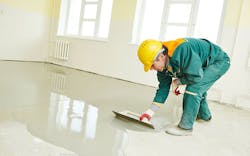Typical story: Mr. and Ms. Consumer want to pretty up their house to sell. They decide to roll some paint over their wood deck. Six months later, the new homeowners are calling in the pros to deal with chipping paint, splinters, weather-related destruction, and a slippery surface. How do you deal with those issues?
It’s a simple equation. When it comes to specialty coatings for things like decks and concrete floors, assessing the situation, preparing the area properly, and choosing the right coating will lead to the best outcome. But for a truly satisfied customer, pro painters need to remember there’s another side to that equation: aligning customer expectations with real-world product performance. “The best contractors are the ones who ask a lot of questions to establish customer expectations,” says Mike Mundwiller, field development manager at Benjamin Moore, and a 33-year veteran of the industry. “They point out the issues they may face as they get into a job and let customers know what products will or won’t do to align their expectations with the real world.”
Hit the Deck
Every region has its weather-related challenges when it comes to outdoor living spaces. The north’s harsh cold and the south’s humidity can wreak havoc on decks. “In Florida, everything molds. You can coat a deck and within three months there’s mildew,” says Rick Ingram, owner of Richard Ingram Painting in Pensacola. Mold and mildew also can create a slipping hazard. And in any environment, paint will peel and flake.
While painters understand that wood decks should be stained and not painted, consumers often don’t. But when it comes to residential work, painters must deal with as-is situations.
Getting out in front of deck surface issues, as Mundwiller says, is all about preparation. “A coating is only as good as the substrate it’s put on.” You want to get the wood as close to brand new as possible. Keep in mind that good, clean wood may also have a lot of splinters. “The coating will adhere, but when you walk on it, the abrasion of foot traffic will take it off. The key is solid surface prep followed by a quality product.”
That means decks need to be pressure washed to remove flaking, peeling paint. “Use low pressure; you’re just trying to remove old product,” cautions Michael Craine, owner of Craine Painting in Lake Geneva, Wisconsin. Otherwise, “you might fur up the wood or tear up chunks.” Follow that by using a walk-behind sander and sand with a low grit to remove anything that’s left. “Don’t stop while you’re sanding, though. You can put a divot in the wood. Maintain even passes.” Then blow off the dust or use a HEPA vac.
Craine uses Benjamin Moore’s ARBORCOAT® on decks. That line includes “a whole portfolio of products— a cleaner and brightener for surface prep, along with various staining products, depending on the opacity the customer is looking for,” Mundwiller says.
Concrete Example
A garage floor—typically rife with rust, oil and grease spots—is another area that needs special attention. Again, the first step is getting the floor good and clean.
Acid etching and pressure washing can help, too. The acid etching may open the pores in the concrete so it will more readily accept a coating. Corotech V620 Concrete & Masony Etcher, a pre-treatment, helps remove laitance (that weak, friable layer on the surface of concrete flooring) and contaminates.
Once the floor dries after preparation, you’ll want to seal it with a coat of Corotech V156 Moisture Tolerant Quick-Set Epoxy Sealer. It will penetrate deep into the concrete, establishing an anchor for the garage floor coating system. “You may have to sand and grind, too,” Ingram says. “If the floor is not cleaned and prepped right, the paint will pull off, and the epoxy may flake off.”
A Slip in Time
With any new surface coating, slipping can become a problem. According to the Consumer Product Safety Commission (CPSC), floors and flooring materials contribute directly to more than 2 million fall injuries each year, with slip and falls accounting for over 1 million hospital emergency room visits.
To add texture and grip, some painters will mix a fine, powdery sand or vinyl paint chips into their coating, depending on the look their clients want. But Mundwiller says there’s a better way to operate.
First, if you put something into the paint or stain and you don’t keep the mixture agitated, whatever you’ve added will fall to the bottom and not get evenly distributed. Mundwiller suggests what he calls the “feed the chickens” method. After rolling out the floor, “take a handful of whatever material you’re adding and throw it up in the air for even distribution. You might even walk on the floor wearing spikes and then back roll it.”
He cautions against using sand “because of the dangers of silicosis. After years, if that floor needs repairs, abrading it is a hazard. Sand is a known carcinogen. I’m not comfortable with that. I prefer using quartz. Also, Benjamin Moore makes a product with fiberglass anti-slip aggregate, Insl-x Sure Step Anti-Slip Coating, that is a good anti-slip solution. But it’s really formulated for foot traffic only and not for cars.”
With any aggregate, you need to be careful that you don’t overdo it. You want the surface to be anti- slip, but you also want cleanability. Too much aggregate will tear up a mop when it comes time to clean. As Mundwiller says, “Any anti-slip characteristic is raising the heel of the shoe just enough to where you don’t hydroplane.”
For every specialty situation, Benjamin Moore has a family of products that can carry you from cleaning to priming to finish coating. For example, there are primers designed specifically for cedar or redwood to block out tannin bleed. There are primers for rust inhibition, and for adhesion. “Our offer of primers is very detailed to meet the specific needs of the contractor on a job-by-job basis for adhesion to various other substrate challenges.”

